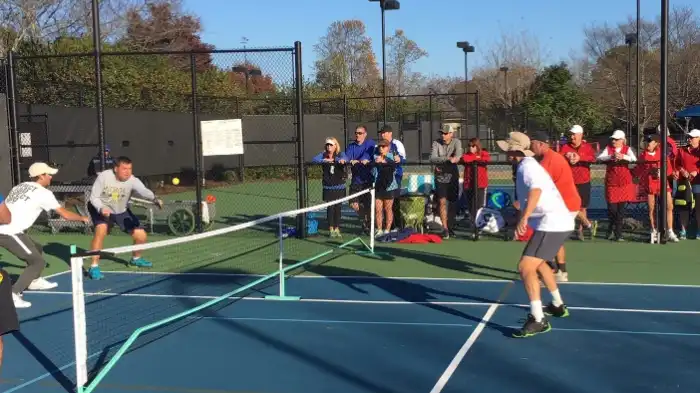Welcome to our guide on pickleball tips specifically designed for intermediate players. As you progress in your pickleball journey, it’s important to build upon your foundational skills and develop advanced strategies to dominate the court. In this blog, we will cover several key tips and techniques to elevate your game and take it to the next level. Let’s dive in!
1. Master Your Serve
The serve is a crucial aspect of pickleball that sets the tone for each rally. As an intermediate player, focus on refining your serve to gain a competitive edge. Here are some tips:

- Experiment with different serve techniques, such as the power serve, spin serve, or lob serve, to keep your opponents guessing.
- Practice serving from different locations on the court to improve your accuracy and consistency.
- Develop a reliable second serve to minimize the risk of double faults.
2. Improve Your Volley Technique
Volleying is a crucial skill that enables you to play more aggressively and control the pace of the game. Consider these suggestions to enhance your volley technique:
- Focus on your footwork and positioning to ensure you are in a balanced position when making volleys.
- Practice using both forehand and backhand volleys to keep your opponent off balance.
- Work on your reaction time and hand-eye coordination to improve your reflexes at the net.
3. Enhance Your Dinking Skills
Dinking is an essential component of pickleball strategy, allowing you to maintain control and set up winning shots. Here are some tips to refine your dinking skills:
- Practice dinking with precision and accuracy, aiming for the opponent’s non-volley zone.
- Develop different dinking techniques, such as cross-court dinks and soft drops, to add variety to your game.
- Focus on improving your touch and control by practicing dinking drills with a partner.
4. Anticipate and Intercept Shots
Being able to anticipate your opponent’s shots is a valuable skill that allows you to intercept and counter effectively. Consider these tips:
- Watch your opponent’s body positioning and racquet angle to predict the direction of their shots.
- Work on your footwork to position yourself optimally on the court, enabling you to intercept shots.
- Study your opponent’s playing style and adjust your positioning accordingly.
5. Develop Strong Groundstrokes
Groundstrokes are shots played from the baseline and are essential for maintaining control during rallies. Here’s how you can improve your groundstroke technique:
- Focus on generating power from your legs and core rather than relying solely on your arm.
- Practice different types of groundstrokes, such as topspin, slice, and flat shots, to adapt to different game situations.
- Work on your footwork to ensure you are in the best position to execute your groundstrokes with accuracy and power.

Conclusion
By incorporating these pickleball tips into your intermediate gameplay, you will see a noticeable improvement in your overall performance on the court. Remember to practice consistently and have fun while pushing yourself to new heights. Pickleball is a game of strategy, agility, and precision – keep learning, evolving, and enjoying the sport!
Frequently Asked Questions
Answer: To improve your serves, focus on consistent placement and varying your serves’ speed and spin. Practice different types of serves, such as the lob serve, topspin serve, and slice serve, to keep your opponents guessing.
Answer: As an intermediate player, you can work on utilizing the “third shot drop” technique to gain an advantage. This involves hitting a soft, controlled shot as your third shot after the serve, aiming to place it close to the net and force your opponents to hit upwards, giving you an opportunity to attack.
Answer: Footwork is crucial in pickleball as it allows you to maintain a balanced stance and quickly reach shots. Improve your footwork by focusing on proper weight distribution, staying on the balls of your feet, and practicing cross-step footwork drills to ensure effective movement on the court.
Answer: When facing aggressive players, strive to maintain a steady defense while waiting for an opportunity to counter-attack. Use soft shots, controlled dinks, and patient play to force them into making mistakes or going for low-percentage shots. Remember, consistency and placement are key against aggressive opponents.
Answer: To improve your skills in the kitchen, practice the “soft game” which involves hitting controlled, soft shots near the net. Learn to anticipate shots, master the timing for drop shots, and practice hitting diagonal dinks to keep your opponents out of their comfort zone. Consistency and precision are vital to succeed in the kitchen.

